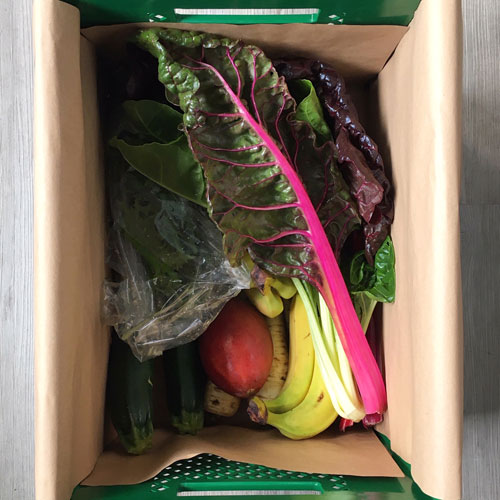Tagebuch Freitag bis Sonntag, 15. bis 17. Oktober 2021 – Erholen
Okay, am Freitag habe ich mich noch nicht erholt, sondern weiterhin mit recht hoher Schlagzahl gearbeitet. Deswegen war das Wochenende auch nur für Rumliegen, Kochen, Essen und Lesen da, und genau das habe ich dann auch gemacht.
Ich hatte kurz überlegt, zum Fußball nach Augsburg zu fahren, wollte dann aber doch eher auf dem Sofa bleiben, und selbst dort hatte ich nicht so recht Lust, das Spiel ganz zu gucken. Noch vor dem blöden Ausgleich durch Bielefeld ausgemacht und lieber Kürbis in Misobutter mariniert. Vielleicht sind Fußball und ich doch allmählich durch. Schade um die gute Stadionwurst.

In der Biokiste war unter anderem eine Tüte Grünkohl, eine Mango (kommt heute ins Mittagsmüsli) sowie wunderschöner Mangold.

Am Freitagabend gab es Pastinaken-Gnocchi, die ich in Butter schwenkte, in der ein bisschen zerrupfter Mangold und Grünkohl waren. Das schmeckte hervorragend, sah aber grauenhaft aus, daher müsst ihr euch das einfach vorstellen.
Unsere freitägliche Date Night begann leider recht spät, weil ich noch werben musste. Daher war der Samstag auch eher zum Ausnüchtern und Käsebrotessen da.

Den Sonntag begann ich spät mit Buttermilk Pancakes, damit die Buttermilch mal alle wird, die ich seit letzter Woche in Maisbrot und Misokuchen verarbeitet hatte. Ist sie jetzt.

Und weil Miso gerade die Zutat der Stunde ist, gab’s abends Kürbis, den ich in Misobutter im Ofen röstete (mit Grünkohl), dazu Pasta.
—
Im Buch High on the Hog: A Culinary Journey from Africa to America erinnern die Schlusskapitel an eine weitere Ebene, in der Nahrung und Politik miteinander verknüpft sind. Ich spreche erneut eine Leseempfehlung aus, aber das kennt ihr ja alle schon. Die Autorin besucht aus anderen Gründen Atlanta und dabei auch Paschal’s, um das „legendary fried chicken“ zu probieren. In den wenigen Sätzen kann man zwischen den Zeilen auch etwas zur Stadtplanung bzw. -entwicklung lesen, die sich bis heute nicht groß geändert hat.
„Paschal’s is one of the restaurants where Martin Luther King and his disciples planned some of their Civil Rights strategy. […] It seems that every Southern city has a similar restaurant in the former black part of the town. During the Civil Rights Movement, it was the place that became the hub where people from the movement met und planned their strategy. […] The menus all harked back to the comfort food of the South: Pig was the preeminent meat, and the pungent aroma of chitterlings often perfumed the kitchen. […] Paschal’s and other places like it, South and North, were pivot points of history: places where black entrepreneurship met up with the growing national movement […] They were hubs in vibrant African American communities. In the North, they were refuges for homesick expatriate black Southeners, places where those who had ridden the trains and walked the roads northward in search of better opportunities could gather and indulge their physical und psychic need for the food of their remembered Southern pasts. In the South, the restaurants were places where African Americans knew that they would be welcomed in establishments when welcome was most assuredly not offered by white establishments. […] The food that flourished in these restaurants during the 1960s and 1970s came to be known as soul food because it fed the spirit as much as the body on the long march to institunionalized equality.“ (S. 199–201)
Im Februar 1960 nahmen vier Schwarze junge Männer an einem Woolworth-Tresen Platz und warteten geduldig darauf, bedient zu werden. Die Greensboro Four sind die heute bekannteste Gruppe von Sit-ins, die mit dafür sorgten, dass die sogenannte Rassentrennung im Süden nach und nach aufgehoben wurde.
„Ella Baker, a Shaw University student and an SCLC organizer, reminded [a conference] that it was about ‚more than a hamburger‘ – an aptly culinary image for a movement that began with four young college students deciding to sit in for their lunch and their rights. The culture-changing protest was not about the mainstream food that was served at the lunch counters: the sixty-five-cent roast turkey, fifty-cent ham and cheese sandwich, or even about America’s totemic apple pie, offered for fifteen cents. It was simply about equality. The sit-ins drew the curtain back from the country’s dirty little secret and showed the inequality of American life to the world. […] Food became the metaphor for society. […] While many Southern whites were content with being served by African Americans who held the jobs of restaurant cook, home domestic, or lunch counterman, they were not prepared to share their space at the counter or the table with those from whose hands they were served daily.“ (S. 205/206)
Harris geht auch noch einmal auf die Entwicklung von „soul food“ ein – und wie sich die Nation of Islam davon distanzierte.
„For the younger generation, the Civil Rights Movement morphed into the Black Power movement, and there was a growing pride in things black and in the culture that had survived enslavement. It went hand in hand with a hunger to learn more about the black experience and a national feeling of solidarity among blacks. In the early 1960s this pride manifested itself in what could be termed a ‚soul‘ movement. […] The word ‚soul‘ was at first used among blacks to establish a cultural community, as in ‚soul brother‘ and ‚soul sister‘. It was initially used to denote kinship in the struggle, in much the same way as the terms ‚brother‘ and ‚sister‘ had been honorifics in the black church for generations. However, as with many other African American cultural innovations, the term was rapidly coopted by the mainstream, and soon there were soul combs on the market along with soul T-Shirts, soul haidos, soul handshakes, and certainly soul music. The term ‚soul food‘ harks back to this era, when everything that was black and of the moment had soul, and the word’s use signaled a change in atitude toward the food of the African American South.“ (S. 206/207)
Harris beschreibt, wie uneinig die Meinungen darüber waren, was genau nun Soul Food war: die Nahrung, von der die Sklaven und Sklavinnen auf den Plantagen leben mussten? Die eher gering geschätzten Teile von tierischer Nahrung wie Innereien und Schweinefüße? War es das Essen, das die vielen Schwarzen Restaurants nun offerierten und sich dabei auf alte Rezepte beriefen? War es, im Gegensatz zur spärlichen Variante, die hier am Anfang genannt wurde, genau das Gegenteil von „Sklavennahrung“: bekannte Zutaten, aber nun mit deutlich mehr Fett und Kalorien und Zucker und Genuss? „Soul food, it would seem, depends on an ineffable quality. It is a combination of nostalgia for and pride in the food of those who came before.“ (S. 208)
Viele Kochbücher aus dieser Zeit, die von Schwarzen verfasst wurden, feierten genau diese Tradition:
„In the 1960s, soul food based on the slave diet of hog and hominy became a political statement and was embraced by many middle-class blacks who had previously publicly eschewed it as a relic of a slave past. It became popular and even celebrated. […] The Nation of Islam (NOI) originated in the early part of the 20th century but came to national prominence in the 1960s […] It preached an Afro-centric variation of traditional Islam and provided a family-centered culture in which gender roles were clearly defined. […] Followers abjured their ‚slave names‘, frequently taking an X in its place and adopted a strictly regimented way of life that included giving up eating the traditional foods that were fed to the enslaved in the South. […] Pork had become so emblematic of African American food that the forbidding of it by the Nation of Islam was radical.“ (S. 208–211)
In den 1970er Jahren verbanden sich verschiedenen Einflüsse auf das Essverhalten Schwarzer Amerikaner:innen. Nahrung blieb politisch, aber trennte nicht mehr.
„Up until the 1970s, the food of African Americans could be loosely categorized by class. The upper classes ate a more European-inspired diet, while the underclass consumed a diet evolved from the slave foods of the plantation South. […] The 1970s, however, exploded all hypotheses. Certainly many African Americans still clung to the traditional foods of the South. However, after the decades of Civil Rights gains and with the growing awareness of the African continent and its diaspora, increasing numbers of blacks of all classes throughout the nation began eating a diet that was widely varied and reflected a newly discovered pride in African roots and international connections. […] the food of African Americans began to evolve into a cuisine that honored hog maws and collard greens and yet allowed for West African foufou, Carribbean callaloo, brown rice, and even tahini.“ (S. 215/216)